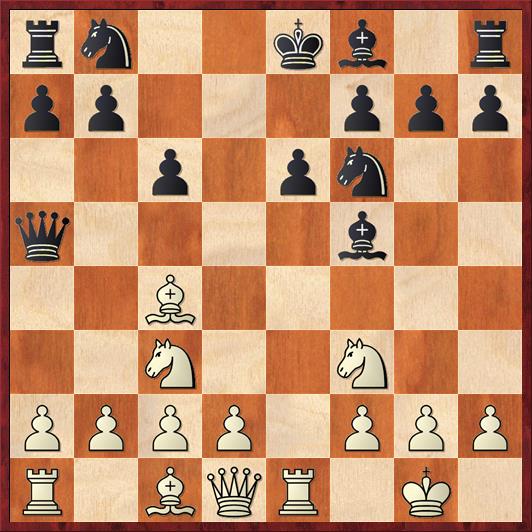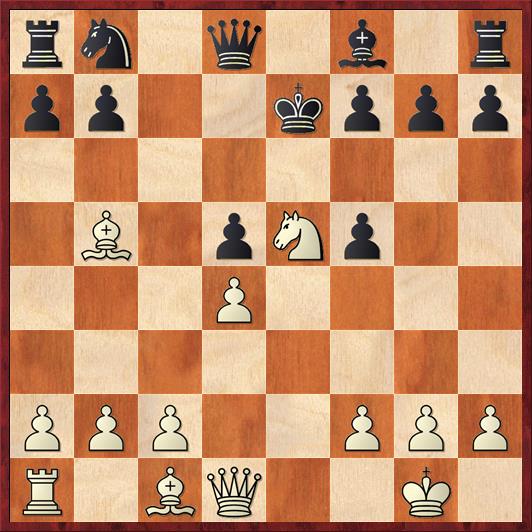Eight years ago, when I was still recording for ChessLecture, I gave a lecture called “My New Favorite Trap.” I talked about a 100 percent risk-free trap in the Center Counter Opening that should be especially effective against players who are “booked up.” Amazingly, according to ChessBase the trap had only been sprung one time in tournament play. (That was a game played in 2005.) Today, out of curiosity, I checked again … and it has still only been played that one time.
Bummer. Obviously no one was listening to my ChessLecture. So I will try again!
Here is the stem position: 1. e4 d5 2. ed Qxd5 3. Nc3 Qa5 (the classical main line) 4. Nf3 (my idea: White delays d4) Nf6 5. Bc4 Bf5 6. O-O e6 7. Re1 c6? (diagram)
 Position after 7. … c6? White to move.
Position after 7. … c6? White to move.
FEN: rn2kb1r/pp3ppp/2p1pn2/q4b2/2B5/2N2N2/PPPP1PPP/R1BQR1K1 w kq – 0 8
So first let me talk about the thinking behind this line. White’s play is a little bit unusual because he has not played the usual d4. I have several reasons for this.
- The knight on c3 won’t be pinned.
- The d-pawn retains the option of going to d3 instead of d4.
- I’m setting a sneaky trap.
Black’s thinking, on the other hand, is that he’s not thinking. He’s just playing memorized moves. This is the way that a lot of players study openings: by learning moves without thinking about the reasons.
In particular, in the main line 1. e4 d5 2. ed Qxd5 3. Nc3 Qa5 4. d4 Nf6 5. Bc4 Bf5 6. Nf3 e6 7. Bd2, Black’s move 7. … c6 serves a purpose — it gives Black’s queen a route to escape from the imminent discovered attack Nc3-d5. In the “Mackenzie trap” the move 7. … c6 serves no purpose, and Black should play 7. … Nd7 instead.
But in ChessBase, the position after 7. … c6? has occurred more times than the position after 7. … Nd7! Why? Because to Black, it doesn’t look as if White is doing anything in particular, so he sees no reason to deviate from his normal plan of development.
So there’s a good chance, especially if your opponent is a theory hound, that you will be able to get to the position above, and then you can spring the trap:
8. Re5! …
White is basically winning in all lines except one. The idea is to sacrifice the rook on f5. Black’s three most reasonable responses are (a) 8. … Qc7, (b) 8. … Qd8, and (c) 8. … Qb4.
(a) 8. … Qc7 9. Rxf5! ef 10. Ng5 Ng4 was played in the stem game, and still only game with this opening in ChessBase, Zvedeniouk-Mortenson, Australian Open 2005. White was easily winning after 11. Qe2+ Qe5 12. Nxf7 Qxe2 13. Nxe2 Rg8 and White wins back the exchange with Nd6+.
I rediscovered this trap over the board while playing in a blitz chess tournament (game/7 minutes) in 2009. That game continued 8. … Qc7 9. Rxf5! ef 10. Ng5 Bd6 11. Bxf7+ Kd7. Here I played 12. g3, which was probably unnecessarily cautious. (Rybka says I should keep on attacking with 12. Be6+! It rates the position as +1.37 for White, which is close to winning.) Nevertheless, I won the game pretty easily, and wondered afterwards if my move had been a theoretical novelty. That’s when I looked it up online and found that it was a theoretical second-ity.
(b) 8. … Qd8 was played against me yesterday by Shredder. Of course I played 9. Rxf5! ef, but then I made an instructive mistake. I should play 10. Ne5! here, with the point that after 10. … Nd5 11. Nxd5 cd 12. Bb5+ Ke7 13. d4! Black has essentially no reasonable moves.
 Position after 13. d4 (analysis). Black to move.
Position after 13. d4 (analysis). Black to move.
FEN: rn1q1b1r/pp2kppp/8/1B1pNp2/3P4/8/PPP2PPP/R1BQ2K1 b – – 0 13
Black can’t develop his bishop. If he tries to develop his knight, he loses it (or the queen). If he tries to evict my knight with 13. … f6, I play 14. Qh5! g6 15. Nxg6. If he tries to develop with 13. … g6, I play 14. Qe2! Kf6 15. Ng4+!! winning.
Unfortunately, against Shredder I forgot my eight-year-old analysis. All I could remember was that the other time I played this variation I had played 10. Ng5, and so that is what I played here. I didn’t stop and think about the differences between Black’s 8. … Qc7 and 8. … Qd8. In essence, I was guilty of playing memorized moves, the same flaw I criticized in other players.
After 8. … Qd8 9. Rxf5 ef 10. Ng5? Nd5! 11. d4 Be7 we actually got a very interesting position that I might discuss in my next post, but it is unfortunately of no theoretical significance because 10. Ne5! is so much better.
(c) Finally, 8. … Qb4 is worth mentioning because it is the only Black move that is somewhat playable. After 9. Rxf5! Black should take the bishop instead of the rook: 9. … Qxc4! 10. d3 Qa6. Although White is way ahead in development, Black might survive because there are no obviously exploitable weaknesses in his position.
So, if you’re playing against the Center Counter, why not give it a try? Just delay d4, castle, move your rook to e1, and see what happens. There is absolutely nothing to fear, because you are always just one move away from the main line. If Black plays the correct 7. … Nd7, you can play 8. d4 and you’re back in the main line again; or you can play 8. d3 if you want to be more original.
Roman Dzindzichashvili once gave a lecture at chess.com about “good traps” and “bad traps.” Good traps are the ones you set while playing normal, strong moves. So even if your opponent doesn’t fall into the trap, you still have a good position. Bad traps are the ones you set by playing inferior moves. Bad traps are a form of “hope chess,” and should be avoided. In this classification, the Zvedeniouk-Mackenzie trap is definitely a good one.



{ 3 comments… read them below or add one }
Nice column and an interesting way to leave a bit of a spike strip out there for your opponent. Here are a few comments/thoughts.
First of all, as noted, Black has several ways to avoid this trap, whether through luck or insight. As you point out, 7 … Nbd7 is the most obvious. Also, Black could have played 5 … Bg4 (a common move when White plays an early Nf3 in the Scandinavian) and avoid this line as well. But since your whole point is that White is playing innocent-looking moves that are also good, White’s not betting the farm on Black’s falling into the pit along the way. If it happens, so be it. If not, no problem.
Second, your 8 … Qb4! does look solid to me. The game is equal, and White’s small lead in development won’t lead to much due to Black’s lack of weaknesses. However, 8 … Qb4 is by no means the obvious move, and someone capable of finding that move probably wouldn’t have reached this position to start with!
Next, you and your readers may recall the Horowitz/Reinfeld book “Chess Traps, Pitfalls, and Swindles.” They also had a delineation of terms that sounds similar to Dzindzi’s lecture. I don’t know if your line would be considered a “trap” or a “pitfall,” but I do recall that “swindles” are more those last-ditch efforts when a player has nothing to lose (aka trying for a “cheapo”), but the refutation of which pretty much ruins the trickster’s game for good.
Finally, my vote for a similar opening trap/pitfall (playing sound and innocent-looking moves in an attempt to catch the unwary) comes out of the Caro-Kann, and has virtually the same pawn structure and development as your line: 1 e4 c6 2 Nc3 d5 3 Nf3 (the Two Knights’ Variation) dxe4 (the savvier Caro player will usually go for 3 … Bg4, but the text is playable) 4 Nxe4. Now, again Black has several perfectly good moves such as 4 … Nd7, 4 … Bg4, or 4 … Nf6, and as in your line they should lead to equal games.
But say the only Caro main line Black knows or likes is the Classical Variation? So, why not 4 … Bf5? (Most of you know what’s coming, right?) Things proceed as usual with 5 Ng3 Bg6 6 h4 h6. Now 7 d4 or 7 h5 Bh7 8 d4 would transpose to the main line of the Classical, but now White instead shows why he has been delaying d4 and plays 7 Ne5! Black naturally continues 7 … Bh7, but is now in a bit of a pickle after 8 Qh5! (computers may prefer the greedy 8 Qf3 Nf6 9 Qb3) g6 9 Bc4! e6. Hmmm, says Black, this isn’t quite what I wanted, but I think I’m OK… and, objectively, he’s still in the game.
Now, White innocently retreats the queen with 10 Qe2. Of course: there’s no other reasonable move here for White, is there? Black emits a small sigh of relief, thinking he’s avoided the worst, and plays 10 … Nf6?? (10 … Qe7 holds White to a small edge, though that Bh7 is ugly). Of course White now reveals his final trick with 11 Nxf7! and Black should retain whatever’s left of his dignity and resign (as my opponent did in a G/45 played about a year ago).
Interesting idea! I’ll definitely give it a try. Thanks!
These lines were interesting.
I stopped for a while trying to finish your line 13…g6, 14. Qe2! Kf6 15. Ng4+! a little further, if they played 15…Kg7 instead of allowing m1. I thought the solution was 16.Bh6+ Kg8 17.Qe8 (threat Qxf8+ and Nf6#) but Black has the very annoying 17…Nd7 18.Bxd7 fxg4. The correct line is 16.Qe5+ f6 17.Nxf6.
{ 1 trackback }